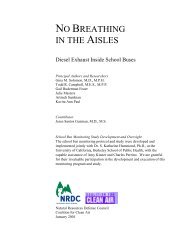NRDC's Ten Best Practices for Textile Mills to Save Money and ...
NRDC's Ten Best Practices for Textile Mills to Save Money and ...
NRDC's Ten Best Practices for Textile Mills to Save Money and ...
Create successful ePaper yourself
Turn your PDF publications into a flip-book with our unique Google optimized e-Paper software.
BEST PRACTICES TO SAvE ELECTRICITY<br />
although electricity accounts <strong>for</strong> only approximately 20 percent of all mill energy<br />
consumption, one practice still achieved sufficient electricity savings <strong>to</strong> qualify<br />
as a best practice: optimizing the compressed air system. if this best practice is<br />
implemented, a mill would save between 2 <strong>and</strong> 59 kWh per <strong>to</strong>n of production—<br />
between 0.3 percent <strong>and</strong> 3 percent of its <strong>to</strong>tal electricity use.<br />
Optimize compressed air system<br />
Instrumentation consumes large amounts of compressed air at many individual locations in a textile<br />
mill, <strong>and</strong> it is susceptible <strong>to</strong> leakage. Compressed air leaks most commonly exist at threaded connection<br />
points, rubber hose connections, valves, regula<strong>to</strong>rs, seals, <strong>and</strong> old pneumatic equipment. In all, air leaks<br />
can account <strong>for</strong> 20 <strong>to</strong> 75 percent of air dem<strong>and</strong> in a plant with no regular maintenance policy. 11<br />
In addition, the working pressure of compressed air is often set according <strong>to</strong> the maximum pressure; it<br />
is often possible <strong>to</strong> reduce this pressure without any negative impacts on manufacturing. Optimizing the<br />
pressure settings saves energy <strong>and</strong> reduces the volume of air loss through leaks. 12<br />
How <strong>to</strong> adopt this best practice: Fix leaks in the system <strong>and</strong> check <strong>and</strong> optimize pressure settings on a regular<br />
basis (at least annually).<br />
AddITIONAL OPPORTUNITIES<br />
Process Improvements<br />
NRDC’s responsible sourcing initiative ten best practices focus on improvements <strong>to</strong> fac<strong>to</strong>ry infrastructure<br />
that provides steam, hot water, <strong>and</strong> electricity <strong>to</strong> the mill, as well as on green initiatives, such as recycling <strong>and</strong><br />
reusing water <strong>and</strong> heat wherever possible.<br />
An equally or greater area <strong>for</strong> improvement is process optimization: modifying the pretreatment, dyeing,<br />
<strong>and</strong> finishing processes themselves <strong>to</strong> use smaller quantities of water or heat. Processes can be modified <strong>to</strong><br />
use smaller quantities of chemicals <strong>and</strong> require less rinsing, <strong>for</strong> example, <strong>and</strong> fac<strong>to</strong>ry production planning<br />
Process recommendations<br />
Undertake a failure analysis when things go wrong<br />
St<strong>and</strong>ardize optimal methods <strong>and</strong> recipes<br />
Substitute enzymes technology in bleaching pretreatment<br />
Investigate opportunities <strong>to</strong> reduce salt in individual<br />
reactive dyeing recipes<br />
Increase reliance on higher fixation dyes<br />
Improve machine utilization<br />
Schedule colors <strong>to</strong> minimize extensive cleaning between<br />
each batch<br />
Moni<strong>to</strong>r continuously <strong>to</strong> check whether implementation<br />
of improvements is in place<br />
can be improved <strong>to</strong> minimize idle machine time.<br />
Most promising is improving “right-first-time”<br />
dyeing rates, which improves profitability <strong>and</strong> on<br />
time delivery <strong>and</strong> substantially reduces the<br />
environmental impact associated with re-processing<br />
fabric <strong>to</strong> correct mistakes.<br />
Mill managers can choose <strong>to</strong> investigate changes<br />
in these areas themselves, with in-house project<br />
teams, or enlist the help of outside experts <strong>and</strong><br />
consultants. Regardless of approach, here are eight<br />
promising starting points <strong>to</strong> begin investigations<br />
<strong>for</strong> improvement.
















